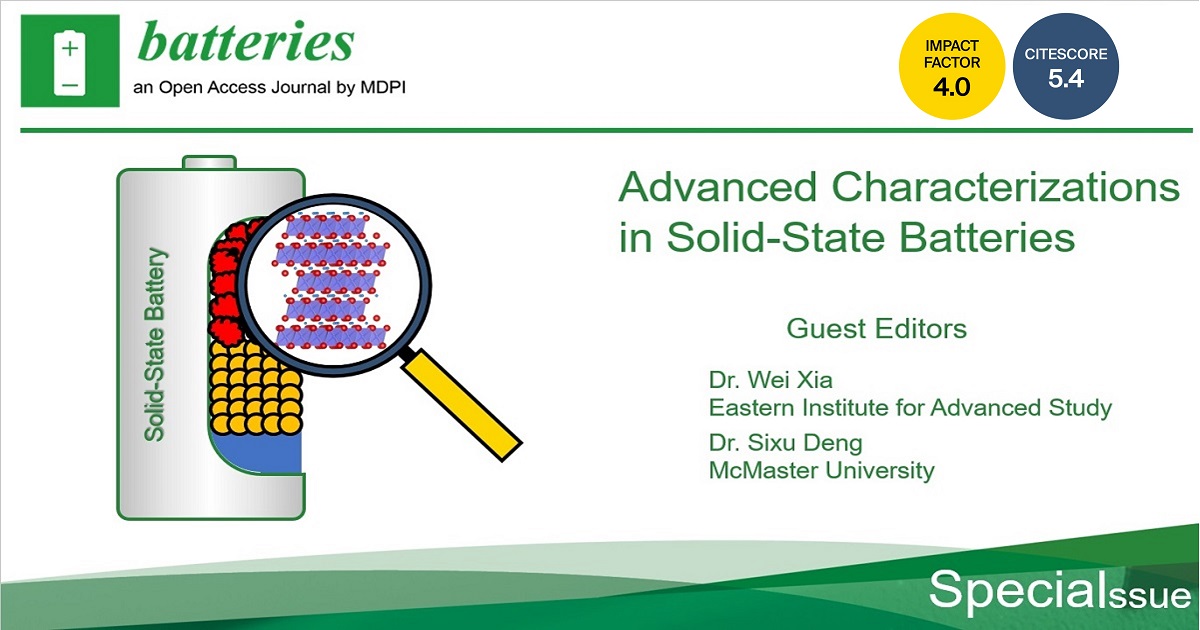Advanced Characterizations in Solid-State Batteries
A special issue of Batteries (ISSN 2313-0105). This special issue belongs to the section "Battery Mechanisms and Fundamental Electrochemistry Aspects".
Deadline for manuscript submissions: closed (10 May 2024) | Viewed by 3243

Special Issue Editors
Interests: electrochemical energy storage and conversion; neutron diffraction
Special Issue Information
Dear Colleagues,
All-solid-state batteries (ASSBs) have attracted intensive research interest and show promising potential as the next-generation of energy storage devices for electric vehicles (EVs). Compared to conventional liquid-based batteries, using solid-state electrolytes (SSEs) in ASSBs offers high energy densities without compromising safety, therefore providing great opportunities to meet the growing demands of long-range EVs. However, the development of ASSBs is at the initial stage and faces significant challenges, such as low ion conductivity of SSEs, chemical/electrochemical unstable toward cathode and anode materials, and big gaps for large-scale indusial production. Therefore, in-depth mechanism studies are essential to realizing high-performance ASSBs. Advanced characterization techniques provide insights into the battery materials’ working/failure mechanisms and therefore give valuable guidance to the design of future ASSBs. Therefore, this Special Issue aims to cover the latest research progress on the advanced characterizations applied in ASSBs. All article types permitted by Batteries are welcome.
Potential topics include, but are not limited to, the following:
- Mechanism studies on solid-state electrolytes;
- Failure analysis on cathode and anode interfaces;
- New characterization techniques in solid-state batteries;
- Calculation, machine learning, and artificial intelligence in battery research.
Dr. Wei Xia
Dr. Sixu Deng
Guest Editors
Manuscript Submission Information
Manuscripts should be submitted online at www.mdpi.com by registering and logging in to this website. Once you are registered, click here to go to the submission form. Manuscripts can be submitted until the deadline. All submissions that pass pre-check are peer-reviewed. Accepted papers will be published continuously in the journal (as soon as accepted) and will be listed together on the special issue website. Research articles, review articles as well as short communications are invited. For planned papers, a title and short abstract (about 100 words) can be sent to the Editorial Office for announcement on this website.
Submitted manuscripts should not have been published previously, nor be under consideration for publication elsewhere (except conference proceedings papers). All manuscripts are thoroughly refereed through a single-blind peer-review process. A guide for authors and other relevant information for submission of manuscripts is available on the Instructions for Authors page. Batteries is an international peer-reviewed open access monthly journal published by MDPI.
Please visit the Instructions for Authors page before submitting a manuscript. The Article Processing Charge (APC) for publication in this open access journal is 2700 CHF (Swiss Francs). Submitted papers should be well formatted and use good English. Authors may use MDPI's English editing service prior to publication or during author revisions.
Keywords
- Li-ion batteries
- Na-ion batteries
- all-solid-state batteries
- advanced characterizations
- interface






